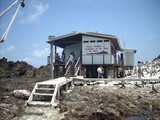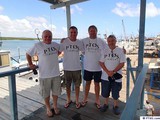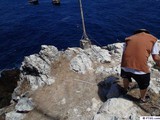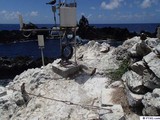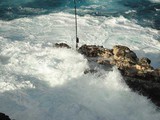PT0S - 10.-23. November 2012
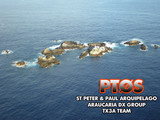
![]() About The Araucaria DX Group
About The Araucaria DX Group
The Araucaria DX Group (GRUPO ARAUCARIA DE DX) was formed in the 70s by mostly Brazilian amateur radio enthusiasts. Today it has become a multinational group focused on contesting and dxing. The group currently has 340 members, of which about 100 are from outside Brazil. The group includes 15 top of Honor Roll and several Contest Hall of Fame members. For details go to: ![]() ext. Link
ext. Link
About the TX3A Team
The TX3A Team of HA7RY and AA7JV have conducted a number of two-man DXpeditions to Chesterfield Reef (TX3A), Mellish Reef (VK9GMW), Serrana Bank - Bajo Nouveo (5K0T) and Willis Islets (VK9WWI). The team focuses on putting difficult places on the air, especially on the low bands.
Press releases
Nov 27, 2012, Natal
The PT0S team has landed in Natal the afternoon of Nov 26, after a 3 day long sea voyage on the not-too-comfortable fishing vessel Transmar II. Everybody is safe and well. We are now catching up on food and sleep. Lots of sleep.
The logs of the last 20 hours of operation were uploaded. Please note that these logs do not contain corrections. (Please also note that it may take several days for LoTW to post the uploaded QSO-s). We will deal with the correction requests during the next two weeks and upload a final and corrected log around Dec 10. (Probably not so final, as correction requests are likely to be coming in for a while.)
We terminated the operation at 10:17 UTC (MM0GPZ was the last QSO), rather abruptly. The Brazilian Navy has requested that we vacate the space we were occupying as they were landing a large number of people for a major upgrade project and simply there was no room for us, either within the facility or outside. Once the decision was made to go QRT, we had to move very quickly to dismantle the station and clean up the site, as the boat had to leave before 2 PM (local time) to arrive in Natal in daylight.
A summary of the operation will be posted here in a few days' time.
Nov 23, 2012, SPSP
PT0S has gone QRT at 10:30 Z.
Thanks for all the contacts and support. Sorry about the QRM.
George, AA7JV
Rainstorm Hits Station
Nov 22, 2012, SPSP
We were hit by a strong rainstorm this morning. As the operating position windows are permanently open, and there are some vents along the upper edges of the wall, we got quite a bit soaked. There was about an inch of water on the floor but we were able to continued operating. No damage to any of the equipment, just a lot of wet clothing. On the bright side, the winds have died almost completely by this morning and the seas have flattened out. Very pleasant, especially after so much rough weather. We just hope the seas will stay like this for the 3.5 day homeward trip..
We continue working the piles ups. During the short openings to JA, the demand is very strong and pile-ups have very high densities that make copy difficult. Still, we are happy as we have over 2500 JA contacts in the log.
There was a very good opening late afternoon on six meters. Interestingly, just a few minutes before the opening 20, 17 and 15 meters went almost completely dead. I was operating 20 m CW and had a huge pile-up. Within one minute the pile-up completely disappeared. There was not even one weak signal to be heard. Almost instantly, the six meter radio cam alive and we had over 200 QSO-s in 90 minutes, mostly with Southern Europe. A very nice surprise! 20, 17 and 15 meters recovered within a few minutes and we had big pile-ups going 15 minutes after the beginning of the disturbance. As we have no Internet access, we could not look at conditions that caused this event.
We may have to go QRT as soon as tomorrow morning (Fri, Nov 23). We will only know in the morning after meeting with the Navy officers in charge of the large project taking place here, and who will be arriving at 06:00 local time.
Low Bands:
We got onto 160 just after sunset at 20:00 Z. We could hear EU stations working each other, but nobody could hear us. We QSY-end to 80 meters, where conditions were worse; 80 sounded like a bad 160. We then moved to 40 and worked both CW and SSB for a few hours, returning to 160 at 21:45 Z, by which time 160 was in decent shape and we were able to work a steady stream of EU stations until about 12:30 Z, when conditions deteriorated. We QSY-end the main station between 40 and 160 a few times, trying to make QSO-s while keeping our fingers in the 160 pie. We finished with 160 at SR but could not hear any JA-s, just the odd NA caller, with mostly weak to very weak signals. We quickly QSY-end to 40 at 07:30 where we were able to work a steady stream of JA-s until about 08:30, when the band suddenly closed to JA. Meanwhile, the second station was working NA, EU and JA on 80 meters, under good conditions until 08:00 Z..
One Radio and Amplifier Lost (11-21-2012 from AA7JV)
Nov 21, 2012, SPSP
Finally we have caught up on some sleep. We rigged up a hammock under the research station that lets us each get a couple of hours of extra sleep during the day. The weather is nice and the waves have moderated. The pile-ups continue unabated. A lot of people are dupe-ing us despite the logs being on LoTW generally within two days of the QSO. We understand making an insurance QSO, but doing more than that is very selfish. The dupe QSO may take the place of a QSO with somebody with no contact at all, and perhaps a new country! So please, no 'serial duping'.
Some have commented on the fact that we spend too much time on 10 meters. This is a result of our set-up: we have two main stations (with amplifiers) that work all bands. A third, bare-foot, station is for 6 meters. We have added a 10 m antenna for the 6 m station, which allows it to be on 10 meters between 6 m openings; which is a lot. The improved weather also means that we have not had any antenna problems and were able to catch up on some small maintenance chores. Unfortunately we lost one radio and one amplifier during the night, but we had spares and we continue to be 100% operational.
We are aiming to stay for the CQWW contest but that is not sure yet at all. More navy activities are planned in the coming days and we will need additional permission to stay during the weekend. Otherwise, we maygo QRT as soon as Friday, Nov 23.
Low Bands:
160: Conditions have been reasonable during the early part of the night, with both Europe and NA coming in with good signals. On the other hand, we feel that we are now working the smaller stations and signals are generally weaker because of that. Fortunately, noise levels have been fairly low. No JA-s yet. The furthest signal report we got was from KH2, where on a well-equipped station our signal was barely detectable. This does not bode well for the possibility JA contacts. Still, we continue listening for JA-s around our sunset and sunrise. (Transmitting on 1825.5 and listening down 2 to 3.) The amount of time we spend on 160 is
being questioned. We have two reasons: One, this is a low band oriented DXpedition, and Two, it is hard to install effective 160 (and 80) meter TX and RX antennas here,. It is likely that future DXpeditions may not go to the trouble.
80: The band was wide open to both Europe and NA most of the night and to JA around sunrise.
40: We have worked some much wanted SSB on 40, as well as a good number of JA-s on CW just after our SR.
George, AA7JV
An Expedition Poorly Planned (?)
20 Nov 2012.SPSP
The weather is nice today, and the waves are smaller too. We continue experiencing issues with antennas: anything exposed here gets smashed, flooded or dragged away. We have located our TX antennas close to the water and are paying the price (and hopefully reaping some benefits).
Because we could not land on a remote rock we had to locate our RX antennas on the highest part of the rock, near the light, and cannot move the TX antennas there. We just simply continue maintaining and strengthening the existing antennas.
Some have commented that this is a poorly planned operation. This is a
fact: most of our plans went out the window the day we landed. We had to improvise because things have changed since our July survey trip. We ended up with a totally different basing, antenna and operating plan. To begin with, we had to share the space of about 3 x 5 meters with a dive team, who used it for most of their dive gear and cameras. Dive gear dripping salt-water is not good company to sensitive radio gear!
Operating while somebody is hanging wet-suits right next you is uncomfortable to say the least. Because of the lack of space, we located one of the stations and most of our gear outside. (Later, when the dive team left and the navy team arrived, we gained the entire space, but we had to move the outside station and all our gear inside. Some of us also sleep there on a folding chair.) The 160 - 10 vertical ended up on a high point of a rocky outcropping: the original location was regularly inundated by huge waves at high tide. We ended up installing our 80 - 10 m vertical in a shallow "crater" instead of the planned tip of a dock.
(The dock was being used by research divers). By the way, the antenna in the crater gets out very well, as the bottom is always covered by 10 to 20 cm of salt water. We cannibalized our Garden Beam Yagi for materials for the 10 m vertical, as the place it was planned to be installed, is now being worked on by a Brazilian Navy construction crew. Instead of being able to locate our RX antennas on the remote rock of Cabral (where I had no problem landing in July) we had to locate our RX antennas on top of Belmonte, Cabral being pounded by 5 meter waves, that often was over it, around the clock.
Our current operations are strongly influenced by the need to work around the local RF noise, the very limited space and the need to continuously repair antennas. Also, because the Internet service of the research station, which we were planning to rely on, is down, we have to spend 3 to 4 hours every day to get the logs uploaded through a 2.4 kbps, low availability satellite link. (One of those LEO-s!) On the other hand, we have two stations on the air virtually all the time, while a 10 and 6 meter station is on the air about 12 hours a day. We now have over 30,000 QSO-s in the log, including 2400 on 160 and 800 on 6. Please keep in mind: there are only the four of us!
Low Bands:
160: Noise was OK this time, but conditions were mediocre. We were on 160 early in the evening, a few times for an hour each during the night and just before our sunrise. No JA-s. At other times, we were using Station One to work JA-s (and others) on 40 and 30 meters.
80: The band started off very poorly but conditions improved later during the night. No JA-s this morning!
40: The band was open all night to EU and NA with strong signals. Both in the earlier part of the night and for a few hours around SR, it was also open to JA, with some very big and stable signals (JH1GNU).
George, AA7JV
Sleepy Operators, Chocolate and Coke Running Out (11-19-2012 from AA7JV)
Nov 19, 2012, SPSP
The waves just never stop. The 10 m vertical got swamped again. this time we have filled the gamma match capacitor with Teflon grease. No salt water can get in there anymore. Also, the CAT5 control cable to the main antenna tuner got shredded by the strong wave action at high tide and the sharp rocks it was laid over. The cable was replaced (and
suspended) this morning. We got buried a few times by some large waves as we did the job at high tide; we did not want to lose the time waiting for low tide. (Low and high tides alternate approximately every 6 hours.
The tidal range on SPSP is about 2.5 meters.)
We are all suffering from a lack of sleep. It is no longer just me, others are starting to fall asleep at the key. (We also ran our Coke, now munching on instant coffee powder to stay awake. Chocolate and other treats have been long gone. It is not that we did not plan sufficiently, but we are sharing with our Brazilian Navy friends: their facility and our stuff.)
Last night we concentrated on Japan on 30 and 40 meters. We feel that it is better to make actual contacts than chase elusive openings on 160 meters.
One aspect of the location is that most bands are open to both Europe and North America at the same time. This results in huge and very difficult to manage pile-ups. Also, a lot of Europeans feel that we favor NA, while some North American stations believe that we favor Europe. For the record, the QSO counts are about even, maybe one or two percent in favor of EU. If we could, we would favor Japan and East Asia, as this is a very difficult QSO for them (especially on the low bands) but we cannot get enough openings to really make a difference.
Low Bands:
160: We spent only a couple of hours on 160. Noise was high. We were not on 160 at our SR.
80: The band was also suffering from atmospheric noise. (A front passed through late yesterday afternoon and early this morning, with its associated lightning activity.)
40: Forty meters was in excellent shape last night and that is where we focused our energies. (And on 30.) Signals were strong from both Europe and NA. Later, around our SR, we were able to work a lot of JA-s. Their signals, however, were very fluttery and difficult to copy.
George, AA7JV
Nov 16, 2012, SPSP
We have started RTTY operations. We have three stations running most of the time. We now have around 17,000 QSO-s, including 1800 on 160.
Winds have increased to 25 kts and continuing large waves and swells make it impossible to install antennas on the remote rocks. On the other hand, we have installed a new low band antenna that is proving to be very useful.
Our main challenge continues to be the very limited Internet access. Log updates are very difficult to send. Logs need to be broken into small enough segments, which must be individually compressed into files of around 15 kbytes each. On some days we end up with 14 or 15 log update messages. Once these are ready to go, I have to climb to the top of Belmont (a steep, rocky climb), set up the computer and the sat-phone and wait for a good satellite pass. Once I have a connection, generally I am able to send our 2 or 3 files or e-mails. The wait for the next good pass... The entire process takes 4 to 5 hours each day, is error prone and very time consuming. Log updates generally run 36 hours behind, and some files need to be resent. So please bear with us!
RTTY: We have big RTTY pile ups. Please note that on RTTY you need to work us only once on any band.
Low Bands: 160 m had good conditions most of the night. It started with a super enhancement as the gray-line passed us. Signals from EU were extremely strong. (One of the ops heard the booming signals through my headphones and asked if I was on the right band.) Once the gray-line passed, conditions became normal with a good steady stream of callers from EU and later NA. Conditions deteriorated around 0400 Z and quickly became very poor. No sign of JA-s last night. We would be interested if there were any spots or RX reports of our signals in JA?
80 m started our very noisy, but the noise dropped once the gray-line passed. 80 also experienced a gray-line enhancement, but not as strong as 160. Conditions during the night were mixed.
40 m has been a steady good performer all night and early this morning.
George, AA7JV
Nov 15, 2012, SPSP
Strong winds and large swells continue but the weather is fine otherwise. We are now running three stations during the day and two during the night.
The very limited Internet bandwidth is a major problem as we have trouble (and large expense) uploading the logs. Also, we do not have enough bandwidth (and time) to deal with individual log search requests.
We intend to make log corrections once we are back on land, but until then the logs are as published. If you cannot find your QSO in the log, please work us again: it will not be a dupe! Also, we are unable to upload pictures at this time.
Today we will do maintenance on the main (160 - 10) vertical, as a large wave has almost knocked it down during the night. Also, we need to move some of the RX antennas as the Brazilian Navy crew is doing their work on the structures we have attached them to. We are also working on a dedicated 10 m vertical to run on that band when 6 meters is not open.
Because of the lack of room, we do not have space to sleep during the day. Because of that, and the daytime workload, we are getting very tired. (I fell asleep at the key on 160 two or three times last night.
Sorry if it caused any confusion.)
Low Bands: 160 was good last night. There was some QSB but not as bad as the night before. Also, the lightning crashes have moderated. Signals from both EU and NA have been most good, with some stations being extra loud. On the average, however, it still takes two to three tries to get a call complete. We made our fist JA QSO this morning. The signals were extremely weak and the QSO was marginal, but we hope that this is a sign of improving conditions towards Asia. We will continue monitoring between 1822 and 1825 for JA and Asia, especially during possible openings.
80 meters has been be excellent. (Our 80 meter vertical, which stands almost all the time in a pool of salt-water, is perhaps our best performing antenna.) We have made a good number of JA contacts during the past few days.
40 meter signals have been extremely good.
George, AA7JV
Nov 14, 2012, SPSP
We continue working the pile-ups, which are very large at times. We also continue adding more RX antennas. Our main challenges are limited Internet access, a difficult physical environment and extremely limited space.
The high speed Internet of the research station, which we had permission to use, has been down for some time and we have been using our back-up Iridium satellite phone, which has very limited bandwidth (2.4 kbps -- yes, kilo). As the logs have grown we are unable to send them in a timely manner, even in a compressed format. We hope to have the Internet access fixed and catch up with the logs soon. Until then, please bear with us and do not 'over-dupe' us.
Low Bands: Variable conditions last night on 160. Initially we had very heavy static noise, which improved towards 2300 UTC but returned around 0600 UTC. There is also substantial QSB. Please pay attention to conditions and when we appear to slow down, send the call-sign twice. We continuously monitor for JA-s (and other Asians) between 1822 and 1825 (down 1 to 3 from 1825.5) especially during potential openings. There is a BC harmonic on 1824, which comes and goes. Please avoid this frequency. Unfortunately, no JA contacts yet on 160, not even faint signals. Today we will work on the main (160) TX antenna hoping to improve it. (The antenna sits on top of a 20 rock outcropping that juts into the water. At low tide it is 20 meters above the water. At high tide the large waves wash over its base. (During the past three days the waves have bunched up all the radials and we feel that performance has
deteriorated.) 80 meters is doing well and we have worked a good number of JA stations. Conditions on 40 are excellent.
AA7JV, George
Nov 12, 2012, SPSP
We continue battling noise. The rocks are covered with scientific instruments that are powered through a number of inverters connected through a network encompassing the entire rock Belmonte. We were planning to install remote RX antennas on a distant rock (Cabral) but large swells have so far prevented us from being able to do so. Winds are down today and we hope the swells will moderate soon. As it is, we got some light injuries, when installing the main TX antenna on the top of a high section of Belmont. One moment we were looking down at the water from the top of a 25 foot cliff, the next moment a huge wave was washing over us. Scary!
The pile ups are large (and somewhat unruly). We will try to do a better job of maintaining them tighter, but we do need cooperation from the callers for that to work. Also, when we are asking for specific regions, we are doing that to make the pile-ups more manageable and put more stations into the log. Please cooperate for your own sake. TKS.
Low Bands: We are hugely challenged on 160 m by noise that is often 20 dB over 9. Anybody who has made us on 160 during the past two nights, has surely got a strong signal! The noise is not continuous, there are some gaps, where it is only S9 +10 dB. That is why we are requesting up
4 sometimes, or some other split number; we are trying to catch a rapidly moving gap in the noise. Yesterday we installed a flag RX antenna on the north facing rock wall. Unfortunately, it had more noise than the TX antenna! That, however, is giving us some hope that we may be able to locate the source of the noise somewhere near the flag. Noise hunting will be the main program today! 80 meters was fair in the morning towards Europe, NA and even Japan. We will be paying special attention to Japan again tomorrow morning (around 0700 UTC). 40 m was excellent this morning, especially towards Japan. Signals were very strong.
We hope that our efforts at noise reduction will be successful and soon we will be more effective on 160m.
30 Meter Frequencies: We will be transmitting on 10,138.5 and listening down. This is to due to local noise.
George, AA7JV
T0S Team on the Rocks, One Station QRV (11-11-2012 from AA7JV)
Nov 11, 2012, St. Peter and St. Paul
We landed on SPSP yesterday morning. After many difficulties we have raised our main antenna and have one station operational. Spent last night on 160 with mixed results. Local noise on the main TX antenna is S9+10 dB and we can only work stations with signals above that. It is like listening to the output of a switching power supply. Will try to build RX antenna today. Conditions are too rough to build the planned remote RX antenna. We must wait for calmer conditions to swim to the remote rock called Cabral.
We have very limited Internet access so updates will be kept short.
AA7JV
PT0S Team Under Way (11-06-2012 from HA5X)
The PT0S team left port in Natal at 17:00 local time (20:00 GMT) and they are now under way to the rocks.
Departure Delayed, New 160 Frequencies (11-06-2012 from AA7JV)
Nov 05, 2012, Natal
We will be leaving the morning of November 06. This means that we are likely to get on the air one day later, the evening of Nov 10.
Also, based on feedback from Europe, where apparently strong Loran like QRM from Russia blankets 1810 to 1820 kHz, we have decided to change our 160m frequency plan: TX 1825.5
RX EU/NA: Up 2-5 (1827 - 1830)- ä RX JA/Asia/VK/ZL: Down 2-5 (1821 - 1825)
